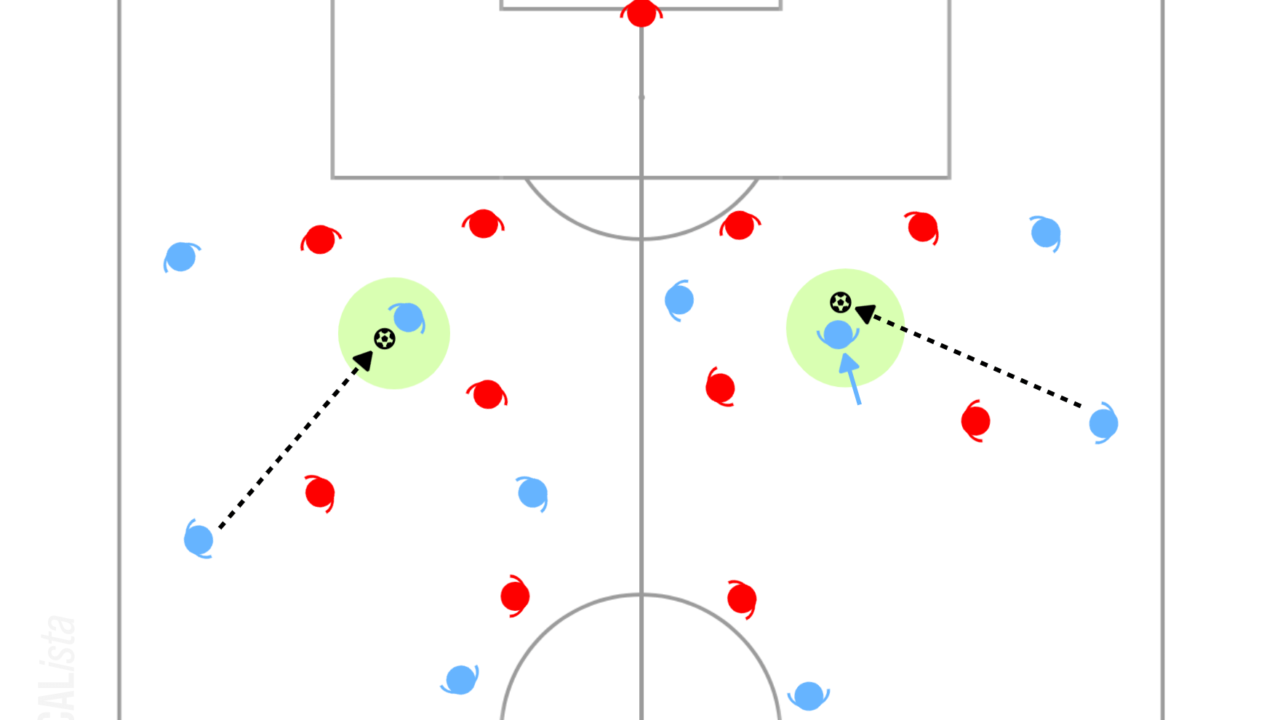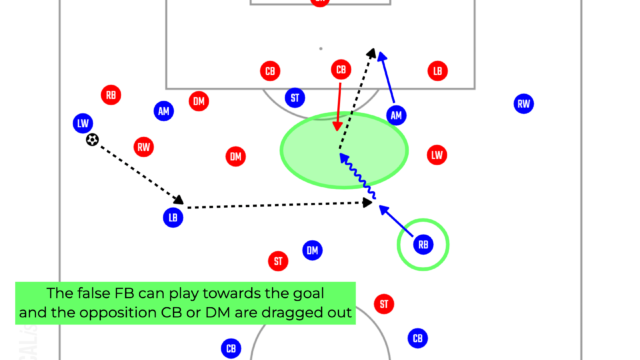How to Exploit the Space between the Lines? [Football Tactical Analysis for Beginners]

Introduction
The space between the lines, especially the midfield line and back line, is a crucial area in the game. The ability of a team to play through and exploit the space between the lines directly relates to the quality of attacking of the team.
The main reasons why playing in between the lines are important are playing over the two or three lines with a long ball is more difficult than playing short and just switching the ball one side to the other is comfortable for the defenders. Of course, it is important to play over to stretch the opposition defensive shape, but the combination of both long balls in behind and short passes in between the lines is more effective. Additionally, switching the ball can force the opposition defenders to shuffle across a lot, which can create gaps between the opposition lines. So, not only just attacking from wide areas after switching the ball but also finding the timing to exploit the gap in the middle is extremely important.
For those reasons, the ability of exploiting the space between the lines can help to improve the quality of attacking. In detail, if an attacker faces forwards with the ball in between the lines, the only job is beating the back line with a one-two or through pass. Moreover, by showing the ability of exploiting the space in the middle, the opposition back line closes the gap to prevent the attacking team from playing through. In this case, by playing to one of the wide areas, the defenders need to turn their body and crosses after that becomes more difficult for them to deal with.
In this article, how to exploit the space between the lines is going to be discussed in detail. I hope you will enjoy it.
Vertical Split Pass from CB
The first pattern is a vertical split pass from a centre back. Thanks to the recent increase of ball-playing centre backs, many of centre backs can play those split passes and this ability is considered as one of the most important skills of centre backs in possession. However, for an attacker to receive the split pass in between the lines, it is difficult to receive it, turn around and face forwards.

Since the ball is played vertically in front of the attacker in between the lines, it is demanding for the player to scan both the ball and the defender in behind. Additionally, the defender can keep seeing the ball and the attacker at the same time, so it is easy to find a timing to step up to intercept the ball or prevent the attacker from turning forwards. Therefore, some skills and preparations are required for the attacker in between the lines.
Firstly, this is too obvious though, the individual skill on the ball is crucial. The ability of controlling the body angle to receive the ball by the back foot and turn forwards in a tight area is the key. Additionally, the ability of keeping scanning the ball and the situation behind the player is also considered as an essential skill. However, these skills are also regarded as an ability for talented players or something to be developed in childhood.
Secondly, the position to receive the ball is also important and this is a skill off the ball. As it was mentioned earlier, the attacker receiving a vertical split pass is likely to be pressed by one of the defenders. To avoid this, being positioned far from the back line is one of the solutions. This can give time for the attacker to turn forwards before the pressure is applied, so it becomes easier to make a better decision.
Finally, the body angle can help to both scan situations well and turn forwards. If the body faces inside, it is possible to see both the ball and the defenders inside of the attacker. This can help the attacker to understand the situation well and make an effective decision towards the goal. Additionally, this body angle allows the attacker to receive the ball by the back foot, making it easy to turn forwards.
In this chapter, the basic skills required for the attacker to receive the ball were mainly analysed. From next chapters, different routes to play the ball into the space between the lines are going to be discussed.
Outside to Inside from Fullback
If the opposition midfield line tries to close the gap inside and forces the centre back on the ball to play outside, a different route should be explored. Closing the middle means giving up the space in the wide areas. Thus, playing to the fullback and then pass the ball to the attacker between the lines is the option.
To create an angle to pass the ball to the attacker between the lines from the fullback, the positioning of the fullback is crucial. If the fullback stays deeper, the opposition wide midfielder can be positioned in between the fullback and attacker to screen the passing lane. Therefore, one of the key things is receiving the ball from the centre back beyond the opposition midfield line. This can help the fullback to have the option to play to the attacker between the lines.

In terms of the attacker between the lines, the weakness of this pattern is that it is required to receive the ball from the back. This might be harder especially in the final third where the attacker needs to play towards the goal. The solution is, it is similar to what was discussed in the previous chapter though, receiving the ball with facing forwards by a well-timed run. This makes it possible for the attacker to face forwards without turning around and it also helps to recognise the situation in front of the attacker.

Therefore, again, it is important for the attacker between the line to be positioned far from the opposition back line to have space to use.
Lay off from Attackers
Another route is using to the striker or wingers up front as a third man and the attacker between the lines receive the ball laid off by one of them.

The benefit is that the attacker between the lines can receive the ball with facing forwards. The pass from one of the attackers up front comes from the direction of the opposition goal, so there is no need to turn forwards.
Another strength of this pattern is that it is effective in the situation where the attackers between the lines are marked by the opposition midfielders tightly. Thanks to the split pass to one of the attackers up front, the defender who is marking the attacker between the lines are forced to turn the body around and often prioritise to watch the ball rather than the attacker. And this is the timing for the attacker to run forwards and lose the marker to receive the ball.
This combination requires qualities of the strikers or wingers. They must be strong enough to hold the ball up under the pressure or cleaver enough to read the timing to drop back to receive the ball away from the pressure. The timing to drop to receive the ball is when the gap in the opposition midfield line appears. It can be when the opposition midfield line is shuffling across or one of the midfielders dragged out to mark the attacker between the lines. For strikers or wingers who do not have strong physical qualities, it is essential to seek and find the timing to receive the ball.
Diagonal Pass from Inside
The final pattern in this article is the diagonal pass to the attacker between the lines from the inside of the pitch. This pass is often played by the defensive midfielders in the middle lane. This is the best way to play to the attackers between the lines.

The angled pass from the inside enables the attacker between the lines to keep watching the ball, the opposition defenders and the goal and face forwards without turning around.
In this pattern, the possible problem is that the passing lane to the attackers between the lines are often cut by the opposition defensive midfielders. When playing to the attacker between the lines diagonally, the available gap is smaller than when playing through vertically. Thus, the attackers need to adjust their positions to make the passing lane available.

Especially when the ball is in the half lane, the diagonal pass to the attacker in the opposite half space can create a great chance. However, one of the common mistakes is being positioned too high and no one can receive the diagonal pass.

This pass can enable the attacker to have overloads against the opposition centre back and fullback, which is a great chance of penetrating into the box.
Conclusion
In this article, various ways to exploit the space between the lines were discussed. Some of key strengths and weaknesses were identified and solutions were provided to overcome the weaknesses. Overall, it is important for the attackers to be positioned far away from the back line to have space in front of them. I hope you enjoyed this article. Thank you for reading.


